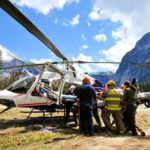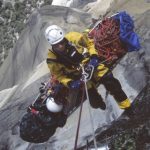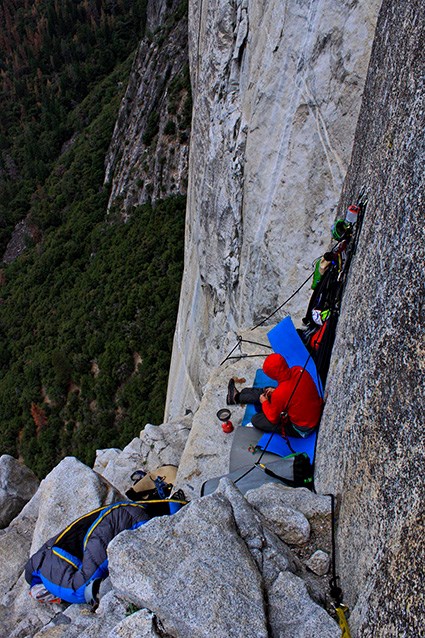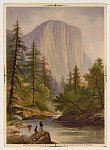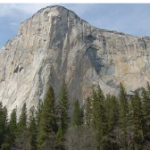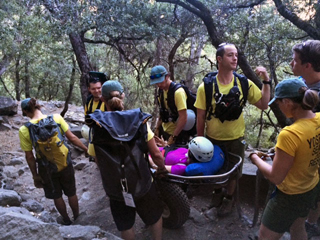National Park Service Search and Rescue (SAR) Ranger John Dill has wise
advice for climbers
to be able to stay uninjured and alive.
See below for his advice on environmental dangers, descents, big wall bivouacs, unplanned bivouacs, loose rock, climbing unroped, leading, falling, learning to lead, the belay chain, helmets, states of mind, rescues, and risks, responsibility and the limits of climbing.
and please see: https://www.nps.gov/yose/planyourvisit/climbing_safety.htm
As of the 2019 version (that he gave me permission to post),
![]()
Staying Alive -by Ranger John Dill
INTRODUCTION
Most climbers do a good job coping with the hazards of their sport, yet more than 100 climbing accidents occur in the park every year. What factors contribute to them? What, if anything, can climbers do to avoid them? And just how dangerous is climbing, anyway? With these questions in mind, the National Park Service (NPS) has examined most of the serious accidents that occurred in the park during the years from 1970 through 1990. The conclusions provide interesting reading for those wishing to stay alive.
IN GENERAL
Fifty-one climbers died in Yosemite from traumatic injuries between 1970 and 1990. A dozen more, critically hurt, would have died without rapid transport and medical treatment. In addition, there were many serious but survivable injuries, from fractured skulls to broken legs (at least 50 fractures per year), and a much larger number of cuts, bruises, and sprains.
Not surprisingly, most injuries occurred during leader falls and involved feet, ankles, or lower legs; for many, these are the accepted risks of climbing. However, leader falls accounted for only 25% of the fatal and near-fatal traumatic injuries; roughly 10% were from rockfall, 25% from being deliberately unroped, and 40% from simple mistakes with gear. Many cases are not clear cut; several factors may share the credit, and it is sometimes hard to quantify the weird adventures climbers have.
Not to be overlooked in the body count are environmental injuries. Inadequately equipped for the weather, four climbers died of hypothermia and perhaps 45 more would have died of the cold or heat if not rescued.
Fifteen to 25 parties require an NPS rescue each year. Sixty more climbers stagger into Yosemite’s medical clinic on their own, and an unknown number escape statistical immortality by seeking treatment outside the park (or at the Mountain Room Bar).
Most Yosemite victims are experienced climbers, 60% have been climbing for three years or more, lead at least 5.10, are in good condition, and climb frequently. Short climbs and big walls, easy routes and desperate ones – all get their share of the accidents.
The NPS keeps no statistics on how many climbers use the park, but 25,000 to 50,000 climber-days annually is a fair estimate. With this in mind, 2.5 deaths and a few serious injuries per year may seem a pretty low rate. It’s much too high, however, if your climbing career is cut short by a broken hip, or worse. It’s also too high when you consider that at least 80% of the fatalities and many injuries, were easily preventable. In case after case, ignorance, a casual attitude, and/or some form of distraction proved to be the most dangerous aspects of the sport.
As the saying goes, “good judgement comes from bad experience.” In the pages that follow are condensed 21 years of bad experience – the situations Yosemite climbers faced, the mistakes they made, and some recommendations for avoiding bad experiences of your own. This information comes in many cases from the victims’ own analysis or from those of their peers.
ENVIRONMENTAL DANGERS
On October 11, 1983 a climber on El Cap collapsed from heat exhaustion.
On October 11, 1984, a party on Washington Column was immobilized by hypothermia.
You can expect this range of weather year round.
Heat
No Yosemite climber has died from heat, but a half-dozen parties have come close. Too exhausted to move, they survived only because death by drying-up is a relatively slow process, allowing rescuers time to get there.
Temperatures on the sunny walls often exceed 100° Fahrenheit, but even in cool weather, climbing all day requires lots of water. The generally accepted minimum, two quarts per person per day, is just that – a minimum. It may not replace what you use, so don’t let the desire for a light haul bag be your overriding concern, and take extra for unanticipated delays. Do not put all your water in a single container, and watch out for leaks.
If you find yourself rationing water, remember that dehydration will seriously sap your strength, slowing you even further. It’s not uncommon to go from mere thirst to a complete standstill in a single day. Continuing up my be the right choice but several climbers have said, “I should have gone down while I could.”
Storms
We still hear climbers say, “It never rains in Yosemite.” In fact, there are serious storms year-round. Six climbers have died of hypothermia and almost 50 have been rescued, most of whom would not have survived otherwise. Several were very experienced, with winter alpine routes, Yosemite walls, and stormy bivouacs to their credit – experts, by most measures. In many cases they took sub-standard gear, added another mistake or two, and couldn’t deal with the water.
Mountain thunderstorms are common in spring, summer and fall. They may appear suddenly out of a clear blue sky and rapidly shift position, their approach concealed by the route you are on. A few minutes warning may be all that you get. Thunderstorms may last only a couple of hours, but they are very intense, with huge amounts of near-freezing water often mixed with hail, strong winds, and lightning. The runoff can be a foot deep and fast enough to cause rockfall. A common result is a panicky retreat, a jammed rope, and cries for help. (The standard joke is that someone will drown on a Tuolumne climb one of these days. It’s actually possible.)
No climber has died in such a storm yet because rescuers were able to respond. No climbers have died from lightning either, but there have been several near misses, and hikers on Half Dome and elsewhere have been killed. Get out of the way of a thunderstorm as fast as you can, and avoid summits and projections.
The big Pacific storm systems have proven more dangerous. They sweep through the Sierra at any time of year, most frequently from September through May. They are unpredictable, often appearing back-to-back after several weeks of gorgeous, mind-numbing weather. It may rain on Half Dome in January and snow there in July. These storms are dangerous because they are usually warm enough to be wet, even in winter, yet always cold enough to kill an unprotected climber. They last from one to several days, offering little respite if you can’t escape.
With no soil to absorb it, rain on the walls quickly collects into streams and waterfalls, pouring off overhangs and down the corner you’re trying to climb up or sleep in. Wind blows the water in all directions, including straight up. It may rip apart a plastic tube tent or blow a portaledge up and down until the tubing breaks or the fly rips. Overhanging faces and other “sheltered” spots are not always immune – rain and waterfalls several yards away may be blown directly into your bivy, and runoff will wick down your anchor rope. Even a slow but steady leak into your shelter can defeat you. Temperatures may drop, freezing solid the next pitch, your ropes, and your wet sleeping bag.
Once cold and wet, you are in real trouble and your options run out. If you leave your shelter to climb or rappel, you deteriorate more rapidly from the wind and water. Even with good gear, water runs down your sleeve every time you reach up. As your body temperature drops, you begin making dumb mistakes, such as clipping in wrong and dropping your rack. You are seriously hypothermic, and soon you will just hang there, no longer caring. It happens quickly. In three separate incidents, climbers on the last pitch of The Nose left what protection they had to make a run for the top. They all died on that pitch. (Read about one of these incidents: Analysis of the Fatalities on The Nose, October 2004.)
Staying put may be no better. If you need help, no one may see you or hear you, and reaching you may take days longer than in good weather. Survivors say they had no idea how helpless they’d be until it happened to them. To find out for yourself, stand in the spray of a garden hose on a cold, windy night. How long will you last?
DESCENTS
Consult the guidebook and your friends, but be wary of advice that the way down is obvious; look the route over ahead of time. If you carry a topo of the way up, consider one for the way down, or a photograph. Your ultimate protection is route-finding ability, and that takes experience. Some trouble spots: North Dome Gully, the Kat Walk, Michael’s Ledge.
• Many rappel epics are born when an easy descent, often a walk-off, is missed. Search for it thoroughly before you commit to a big drop – it may be well worth the effort.
• Conversely, footprints and rappel anchors often lead nowhere – they were someone else’s mistake. Be willing and able to retrace your steps and remember that the crux may not be at the top.
• To further evaluate an uncertain descent, consider rappelling a single line as far as possible (160 feet on rope, 320 feet if two). Learn to be comfortable on the rope and be willing to swing around a corner to look for the next anchor. Carry enough gear to go back up your rope and know how to use it.
• Any time you can’t see anchors all the way to the ground, take the gear to set your own. That includes established descents, since ice and rockfall frequently destroy anchors. It sometimes means carrying a bolt kit.
• Consider taking a second (7-9mm) rope, even for one-rope descents and walk-offs. You’ll save time, depend on fewer anchors, leave less gear, and more easily reverse the climbing route in an emergency. This is the one advantage of leading on double ropes. But don’t forget that thinner ropes are more vulnerable to sharp edges.
• Friction from wet or twisted ropes, slings, ledges, cracks, and flakes may jam your rope. Plan ahead when you rig the anchor and be willing to leave gear behind to avoid friction. You can retrieve the gear tomorrow.
• Rappelling through trees? Consider short rappels, from tree to tree. It’s slow but avoids irretrievable snarls.
• Is your rope jammed? You can go back up and rerig if you still have both ends, so keep them until you’re sure it will pull or you have to let go. If you do have to climb that rope, be careful that it isn’t jammed by a sharp edge. Don’t forget to untie the knots in the ends before you pull.
• Dropped ropes and gear can be more than just embarrassing; without a rescue, a stranded climber is a dead climber, even in good weather. When transferring gear, clip it to its next anchor before unclipping it from the current one.
Below a painting of climbers on their portaledge
from the Yosemite Valley main Visitor Center display Climbing and Stewardship:
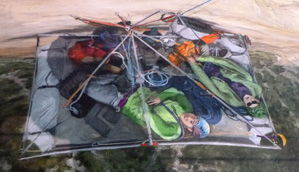
BIG WALL BIVOUACS
Despite the grim scenario above, reasonable precautions will turn stormy big-wall bivouacs into mere annoyances:
• Check the forecast just before you start up but don’t rely on it. For several parties it provided no warning whatsoever.
• Assume you’ll be hit by a storm, and that you’ll not have a choice of bivies.
• Ask friends to check on you if the weather or forecast turns bad.
• Evaluate ahead of time the problems of retreat from any point on the route. Did you bring a bolt kit? How about a “cheater stick” for clipping into bolt hangers and stuffing cams into out-of-reach cracks as you flee down an overhanging pitch?
• If it’s starting to rain, think twice about climbing “just one more pitch” – once wet you won’t dry out. It’s better to set up your bivy while you’re still dry.
• Frozen ropes are useless for climbing or retreating, as several parties found out. Put them away early.
All such hints and tricks aside, the bottom line is your ability to sit out the storm. Your first priority is to keep the wind and outside water away. Second is to be insulated enough to stay warm, even though you are wet from your own condensation.
• Stick with high quality gear in good condition, and don’t leave key items behind to ease the hauling. Don’t go up with a poorly equipped partner; it will be your neck as well.
• For insulation, never rely on cotton or down (even if it’s covered with one of the waterproof/breathable fabrics). Even nylon absorbs water. Wool, polypropylene, and polyester insulators stay relatively warm when wet, and synthetics dry fastest. Take along long underwear, warm pants, sweater, jacket, balaclava/hat, gloves, sleeping bag, insulating pad, extra socks or booties, and plenty of food and water – dehydration hastens hypothermia.
• For rain, use coated nylon, sailors’ oilskins, or the waterproof/breathable fabrics. Take rain pants and jacket, overmitts, bivy bag, and hammock or portaledge with waterproof fly. The fly is critical – it must overlap your hammock generously and be of heavy material, in excellent condition, with strong, well-sealed seams. For sleeping on ledges, take a big tent fly or a piece of heavy-duty, reinforced plastic and the means to pitch it. Then hope that your ledge doesn’t turn into a lake. Do you know to run your anchor through the fly without making a hole? Did you spend more for lycra than rainwear?
• WARNING: Several climbers have blamed the waterproof/breathable fabrics for their close calls. They claim that no version of it can take the punishment of a storm on the walls. Whether true or not, you must be the judge; test all of your gear ahead of time under miserable conditions, but where your exit is an easy one.
For more information on bad weather, including a description of the waterproof anchor, see “Surviving Big Walls,” by Brian Bennett, Climbing, Feb. Mar. 1990.
Unplanned Bivouacs
Getting caught by darkness is common, especially on the longer one-day climbs and descent routes, e.g., Royal Arches and Cathedral Rocks. It happens easily – a late start, a slow partner, off route, a jammed or dropped rope, or a sprained ankle. Usually it’s nothing to get upset about, but if you are unprepared, even a cold wind or a mild storm becomes serious. One death and several close calls occurred this way. To avoid becoming a statistic:
• Consider the following gear for each person’s day pack: long underwear, gloves, balaclava, rain jacket and pants (which double as wind protection). In warmer weather, all can be of the lightweight variety. If that’s too heavy for you, at least take on of those disposable plastic rainsuits or tube tents that occupy virtually no space. Take more warm clothes in colder weather. A headlamp with spare bulb and new batteries is very important for finding safe anchors, signaling for help, or avoiding that bivy altogether. Matches and heat-tabs will light wet wood. Food and water increase your safety after a night of shivering.
• Keep your survival gear with you whenever practical, not with your partner – climbers get separated from their gear, and each other, in imaginative ways, sometimes with serious consequences.
• Standing in slings on poor anchors is not the way to spend a night. If a bivy is inevitable, don’t climb until the last moment; find a safe, sheltered, and/or comfortable spot while you’ve got enough light.
LOOSE ROCK
There’s plenty of it in Yosemite. Ten percent of all injuries are associated with rockfall, including six deaths and one permanent disability. In several other deaths, loose rock was implicated but not confirmed, e.g., possible broken handholds and failed placements. Spontaneous rockfall is not the problem – all the fatal and serious accidents were triggered by the victim, the rope, or by the climbers above.
Rocks lying on ledges and in steep gullies are obviously dangerous. Not so obvious is that old reliable mantle block, five times your weight, wedged in place, and worn smooth by previous climbers. Yet with distressing regularity, “bombproof” blocks, flakes, and even ledges collapse under body weight, split out cams, or fracture from the pressure of a piton. The forces placed on anchors and protection, even from rappelling, may be far higher than you generate in a test. Handholds may pass you scrutiny, then fail in mid-move. The rock you pull off can break your leg after falling only a couple of feet. Finally, watch out for rotten rock, responsible for at least two of these fatalities. It’s common on the last couple of pitches of climbs that go to the rim of the Valley, e.g., Yosemite Point Buttress and Washington Column.
The East Buttress of Middle Cathedral Rock is a well-known bowling alley, the site of many rockfall injuries. The Northwest Face of Half Dome is another, with the added excitement of tourist “firing squads” on the summit. But the most dangerous, surprisingly, may be El Cap; on rock so steep, loose blocks balance precariously and big flakes wait for an unlucky hand to trigger the final fracture.
Some rockfall accidents may not be preventable, short of staying home, but being alert to the hazard and following a few guidelines will cut the injury rate:
• Consider a helmet for loose routes.
• Throw in an occasional piece on long, easy runouts, as insurance against the unpredictability of the medium.
• Avoid rotten rock as protection, even if you can back it up. When it fails it endangers everyone below.
• Ropes launch almost as many missiles as climbers do. Watch where you run your lead rope. Use directionals to keep it away from loose – and sharp – stuff, and check it frequently. Keep in mind that your bag or pack, when hauled, may dislodge everything in its path. When you pull your rappel ropes, stand to one side, look up, and watch out for delayed rockfall.
• You have no control over a party above you, and by being below you accept the risk. If you are catching up, don’t crowd them – ask for permission to pass. You can probably get by them safely, but remember that climbers have been killed or hurt by rocks dislodged by parties above, including those they allow to pass. The party you want to pass may have gotten an early start to avoid that risk, and they have no obligation to let you by. When you are above someone else, including your partner, put yourself in their shoes. Slow down, watch your feet and rope.
CLIMBING UNROPED
Everybody does it, to some extent. There’s no reason to stop, but good reason to be cautious: fourteen climbers were killed and two critically injured while deliberately unroped. At least eight climbed 5.10 or better. Most, if not all, of those accidents were avoidable. You may find yourself unroped in several situations – on third-class terrain, spontaneously on fifth-class, and while deliberately free-soloing a route.
Third class terrain may be easy, but add a bit of sand, loose or wet rock, darkness, plus a moment of distraction, and the rating becomes meaningless. Four climbers have died this way, typically on approach and descent routes such as North Dome Gully, all in spots that did not demand a rope.
Sometimes you lose the way on the approach, or unrope at what you thought was the top of the climb, only to find a few feet of “easy” fifth-class blocking your way. Your rope is tucked away in your pack, and you’re in a hurry. Before you go on, remember that you didn’t plan to free-solo an unknown quantity today. Four died this way, falling from fifth-class terrain that they were climbing on the spur of the moment.
Seven of the 14 killed were rappelling or otherwise tied in. They unroped while still on fifth-class rock, for various reasons of convenience, without clipping into a nearby anchor. Three slipped off their stances, a ledge collapsed under another, one decided to down-climb the last few feet, and two tried to climb their rappel ropes hand-over-hand to attend to some problem. Like the previous group, they all went unroped onto fifth-class terrain on the spur of the moment. In addition, they all had a belay immediately available. Did its nearness give them a false sense of security?
No true free-soloer has been killed yet, although one, critically hurt, survived only by the speed of his rescue. A death will happen eventually, possibly the result of a loose hold. Is the free-soloer more alert to the task, having planned it in advance, than those who unroped on the spur of the moment? Were the unlucky fourteen still relaxed in their minds, not quite attuned to their new situation? We can only speculate.
Keep these cases and the hidden hazards in mind as you travel through any steep terrain. Be aware of what is under foot, and in hand, at each moment. Be patient enough to retrace your steps to find the easy way, and if there’s a belay hanging in front of you, think twice before rejecting it. Finally, remember that your climbing ability has probably been measured on clean, rated routes, not on unpredictable sand and wet moss. Being a 5.11 climber does not mean you can fly.
LEADING
Nine climbers died and six were critically injured in leader- fall accidents involving inadequate protection. Most fell simply because the moves were hard, and several were victims of broken holds. They were all injured because they hit something before their protection stopped them. Either they did not place enough protection (one-third of the cases) or it failed under the force of the fall (the remaining two-thirds). In every case, their injuries were serious because they fell headfirst or on their sides – the head, neck, or trunk took a lethal blow. Half fell 50 feet or less, the climber falling the shortest distance (25 feet) died, and the longest (270 feet!) survived.
Were these catastrophes avoidable? It’s sometimes hard to tell, but the answer is often yes. Here are a few lessons frequently learned the hard way:
• Climbers frequently describe the belaying habits they see on Yosemite routes as “frightening.” Before you start up, how frightening is your belay? Can the anchor withstand pulls in all directions? Is there more than one piece, with the load shared? Is the tie-in snug and in line with the fall force? Is your belayer experienced with that belay gadget and in position to operate it effectively when you fall? (You’d be surprised.) Will you clip through a bombproof directional as you start up, even on an easy pitch?
• Don’t cheat on your ground fall calculations. (A good belayer will keep you honest.) With rope stretch and slack in the system, you may fall twice as far below your last protection as you are above it – if it holds.
• Nuts want to fall out. One that self-cleans below you may turn a comfortable lead into a ground-fall situation. Or, during a fall, the top piece may hold just long enough for the rope to yank the lower nuts out sideways, and then also fail. For more reliable placements, set those nuts with a tug and sling them generously. A tug on a marginal nut, however, is worthless as a test. Tiny nubbins may hold it firmly under those conditions but give way in a fall. Be especially cautious about placements you can’t see. Back them up.
• Camming devices “fail” regularly, but it’s seldom the fault of the device. It’s more likely due to haste, coupled with undeserved faith in technology. As with nuts, a blind placement – often in a layback crack – may feel solid but be worthless.
• Fixed pitons loosen from freeze-thaw cycles and repeated use. They may not have been installed well to begin with. A hammer is the only reliable way to test and rest them, but you don’t see many hammers on free routes these days. You don’t see them on rappel routes, either, but you may find yourself hanging from anchors that belong in a museum. If you don’t test pitons properly, do not depend on them – routinely back them up.
• There is no reliable way to test bolts but plenty of reasons to want to. For example, the common ¼” split-shaft type was not designed or intended for life support, let alone for rock climbing. Their quality varies; several have broken under body weight, and others like them await you. Reliability also depends on the quality of the rock and the skill of the bolter. Add years of weathering and mistreatment by climbers and the result is many bolts that are easily pulled out by fingers or a sharp yank with a sling. Several bolt hangers have cracked as well, with one fatal accident so far.
• Never test a bolt with a hammer. Instead, examine the surrounding rock, the bolt, and the hanger for cracks, and hope they are large enough to see. Is the bolt tight and fully seated in the hole? Is the nut snug?
• Back up all untested fixed protection.
• Okay. So you know this stuff. You’re a little shaky on the lead right now and you’ve had some trouble getting your pro to stick, but the book said this was a 5.10a, and besides, two teenage girls just walked up this pitch. It’s only 20 feet more and one of those pieces is bound to hold. Think for a minute. Are you willing to free-solo this pitch? Keep your answer in mind as you climb, because poorly placed protection amounts to just that.

About Falling
There’s an art to falling safely – like a cat. Bouldering helps build the alertness required. Controlling your fall may be out of the question on those 200-foot screamers, but it will reduce the risk of injury from routine falls. Whenever possible, land on your feet – even if it breaks your leg, absorbing the shock this way may save your life. Laybacks and underclings hold special risk in this regard – you are already leaning back, and if you lose your grip the friction of your feet on the rock may rotate you into a headfirst – and backward – dive.
• A chest harness will not keep you from tumbling as you free fall, but it will turn you upright as the rope comes tight. This reduces the chance of serious injury during the braking phase and may be life-saving if you hang there for long, already seriously hurt.
• The wall may look vertical below you, but even glancing off a steep slab can be fatal. Three climbers died this way.
• Pendulum falls are particularly dangerous. If you swing into a corner from 20 feet to one side of your protection, you will hit with the same bone-breaking speed as when striking a ledge in a 20- foot vertical fall. The crucial difference is, you are “landing” on your side, exposing vital organs to the impact. Two climbers died this way and others suffered serious injuries. Even small projections are dangerous: a 20- foot swing on Glacier Point Apron fractured a skull, and another smashed a pelvis. In a pendulum there is no difference between a leader and a follower fall; don’t forget to protect your second from this fate as you lead a hard traverse.
Learning to Lead
Four of the 15 killed or critically injured in leader falls were good climbers on well-defined routes, but the majority were intermediates, often off-route. There may be a couple of lessons in that.
• Don’t get cocky because you just led your first 5.8 or your protection held on your first fall. Experienced climbers have died from errors “only a beginner would make,” so you have plenty of time left in your career to screw up.
• Climbing and protecting are separate skills but both keep you alive. Don’t challenge yourself in both at the same time – you might not have the skill and presence of mind to get out of a tight spot. If you’re out to push your limits, pick a route that’s well defined and easy to protect, place extra pieces for practice, and be willing and equipped to back off.
• Route finding is another survival skill. A mistake here can quickly put you over your head in climbing, protecting, or both. Learn to look ahead and recognize what you want to avoid. Climb it mentally before you climb it physically.
• Some “easy” terrain in the valley is actually pretty dangerous. Low-angle gullies are often full of loose blocks cemented together with moss. Opportunities for protection may be scarce and route finding subtle. These are not usually cataloged routes. Three or four climbers have been killed, or nearly so, on such terrain while looking for easy routes to climb.
A Leading Problem
The last pitch of The Nutcracker provides a subtle challenge for the fledgling 5.8 leader. Once over the mantle, you may relax as you contemplate the easy climb to the top. But if you forget about your protection, a slip in the next few moves may send you back over the side to crash into the slab below. This pitch has scored several broken ankles when the fall was longer than expected, and a more serious injury is possible. There are many such situations in the Valley, and one key to safety is to look below you while you plan ahead.
THE BELAY CHAIN
Whether you are climbing, rappelling, or just sitting on a ledge, the belay chain is what connects you to the rock. There are many links, and mistakes with almost every one have killed 22 climbers, 40% of all Yosemite climbing fatalities. In every case the cause was human error. In every case the death was completely preventable, not by the subtle skills of placing protection on the lead, but by some simple precaution to keep the belay chain intact. Experienced climbers outnumbered the inexperienced in this category, two to one.
Mistakes with the belay chain occur at any time. Make one and you’ll fall to the end of the rope … or farther. Minor injuries are rare. Here are some key points to remember:
• Before you commit yourself to a system, always apply a few pounds of tension in the direction in which it will be loaded, analyze it like an engineer – what if this happens … or that? Check every link, from the buckle of your harness to the rock around your anchor. You would be amazed at the inadequate systems often used by experienced climbers, even though it takes only a few seconds to run a proper check.
• Both lives depend on that system, so go through it with your partner. Nine climbers have died in multi-victim accidents.
• Check the system periodically while you’re using it. Forces may change direction (two died when their anchors failed for this reason), ropes and slings can wear through (serious injuries and one death) and gear can come undone (two died when a wiggling bolt hanger unscrewed its nut – they were relying on a single bolt.)
• Are you about to rappel? Stay clipped to the anchor for a few seconds. Check both the anchor and your brake system, as above. If one anchor point fails, will you remain attached to the others? Are the knots in your rappel slings secure? Did you check every inch of those fixed slings for damage? Skipping these precautions cost eight lives plus serious injuries, from poorly tied slings, partially dismantled anchors (a simple misunderstanding), relying on single carabiners, and other reasons. The next accident may be caused by something new, but it will have been preventable by double-checking.
• Two climbers died by rappelling off the ends of their ropes, event hough both had tied knots in the ends as a safety measure. In one case the knots pulled through the brake. In the second, the victim forgot to double-check the ropes after a knot had been untied to deal with a problem. Knots are still a recommended safety procedure, but do not take anything for granted. Tie both strands into one knot or knot each separately – there are pros and cons to each method.
• When rappelling in unpredictable circumstances – dark, windy, poor communications, unknown anchors below – consider a Prusik Hitch or a mechanical ascender as a safety. If improperly handled, neither one may stop you if you fall – they are primarily for quickly but deliberately stopping yourself to deal with other emergencies. Both of those who rappelled off their ropes would have survived with safeties.
• In separate incidents, five climbers somehow became detached from their ropes while climbing with mechanical ascenders – not the fault of the devices. Only three were tied to their ropes at all, at the lower end. All five died because they had not tied in “short,” leaving themselves open to a long fall. To tie in short, tie a loop in the rope a few feet below your ascenders and clip it to your harness. As you climb, repeat the process often enough to limit your fall should you come off your rope. At the very least, do this when you must pass at least one ascender around protection, traverse (three deaths), or change to another rope. (Is that other rope anchored well? One climber died, partly because his wasn’t. Ask your partner first.) In addition, always be tied in to both of your ascenders.
• Self-belayers should also tie in short – one died when his Prusik belay melted during a fall (a Prusik cord too large for the rope). At least two were treated to close calls when other types of self-belay systems jammed open.
• Clip into a new belay point before unclipping from the old one. During those few, vulnerable seconds, pitons have pulled, hero loops have broken, rocks have struck, and feet have slipped.
• Three climbers were killed and one critically injured by “failures” of single-carabiner tie-ins and rappel anchors. Be careful of relying on a single non-locking carabiner for any link in the chain. The rope or sling may flip over the gate and unclip itself, especially if it is slack, or shock-loaded. Even if you watch it carefully and/or it is “safely” under tension, you may become distracted. One climber died while his Figure Eight descender unclipped while he was busy passing a knot on rappel. (He should have tied in short.) For those critical points, use either two non-locking carabiners with gates opposed and reversed, or a locking carabiner. Don’t forget to lock it! For many applications the two-carabiner method is safer and faster to operate.
• Ropes have been cut in three fatal accidents. They did not break, but were stressed over sharp edges, a condition never intended by the manufacturer. Two of these accidents were avoidable: one climber should have tied in short to prevent a 100 foot fall that cut the rope; the other should have protected a fixed rope from a well-defined sharp edge. Ascending a rope produces a weighted, see-sawing action that can destroy it, even over a rounded, moderately rough, edge.
• As with ropes, most gear failure falls into the misuse category. Failure from a design or manufacturing flaw is rare. It was the initiating factor in one fatal accident – three climbers died when a bolt hanger broke at a two-bolt rappel anchor. The tragic outcome would have been avoided, however, had the climbers noticed they were not properly backed up to the second bolt.
These cases illustrate one of the rules most commonly overlooked: BACK YOURSELF UP. No matter what initially pulled, broke, slipped, jammed, or cut, the incident became an accident because the climber did not carefully ask himself, “What if…?” By leaving yourself open, you are betting against a variety of unpredictable events. You don’t lose very often, but when you do, you may lose very big.
Beginners!
From your first day on the rock, you have the right to inspect, and ask questions about, any system to which you’ve committed your life. It’s a good way to learn, and a good way to stay alive. If your partner or instructor is offended, find someone else to climb with. Never change the system or the plan, however, without your partner’s knowledge.
HELMETS
While we can never know for certain, helmets might have made a difference in roughly 25% of the fatal and critical trauma cases. They would have significantly increased – but not guaranteed – the survival chances for five of those fatalities. Furthermore, helmets would have offered excellent protection against less serious fractures, concussions, and lacerations.
Most deaths, however, involved impacts of overwhelming force or mortal wounds other than to the head, i.e., beyond the protection offered by a helmet. This is not an argument against helmets; the point is, a helmet doesn’t make you invincible. What goes on inside your head is more important than what you wear on it.
When to wear a helmet is a personal choice, but it is especially recommended for the following: beginners pushing their skills, roped solo climbing, a high risk of a bad fall or of ice fall (several El Cap routes in winter and spring), and for all approaches, descents, and climbing routes that are crowded and/or particularly loose.
STATES OF MIND
This is the key to safety. It’s impossible to know how many climbers were killed by haste or overconfidence, but many survivors will tell you that they somehow lost their good judgement long enough to get hurt. It’s a complex subject and sometimes a touchy one. Nevertheless, at least three states of mind frequently contribute to accidents: ignorance, casualness, and distraction.
Ignorance
There is always more to learn, and even the most conscientious climber can get into trouble if unaware of the danger (“I thought it never rained…”). Here are some ways to fight ignorance:
• Look in the mirror. Are you the stubborn type? Do you resist suggestions? Could you be a bit overconfident? (Ask your friends.) Several partners have said of a dead friend, “I wanted to give him advice, but he always got mad when I did that. I didn’t realize he was about to die.”
• Read. The climbing magazines are full of good recommendations. Case histories in the American Alpine Club’s Accidents in North American Mountaineering, a yearly compilation of accident reports, will show you how subtle factors may combine to catch you unaware. Such accounts are the next best (or worse?) thing to being there.
• Practice. Reading may make you aware but not competent. In fact, you can be dangerously misled by what you read, including this report – important details are often left out, the advice may be incorrect, and in the long run you must think and act for yourself. Several climbers, for example, waited to learn Prusiking until it was dark, raining, overhanging and they were actually in trouble. They had read about it, but they had to be rescued despite having the gear to improvise their own solutions. Book-learning alone gave them a complacency that could have proved fatal.
Casualness
“I just didn’t take it seriously,” is a common lament. It’s often correct, but it’s more a symptom than a cause – there may be deeper reasons for underestimating your risk. Ignorance is one, and here are some more:
• Habit reinforcement. The more often you get away with risky business the more entrenched your lazy habits become. Have you unconsciously dropped items from your safety checklists since you were a chicken-hearted (or hare-brained) beginner?
• Your attitudes and habits can be reinforced by the experiences (and states of mind) of others. The sense of awe and commitment of the 1960’s is gone from the big-wall trade routes, and young aspirants with no Grade VI’s, or even V’s to their credit speak casually about them. Even for experts, most accidents on El Cap occur on the easier pitches, where their guard is down.
• Memory Decay. “I’m not going up again without raingear – I thought I would die!” A week later this climber had forgotten how scared he had been in that thunderstorm. Raingear was now too heavy and besides, he was sure he’d be able to rap off the next time. Many of us tend to forget the bad parts. We have to be hit again.
• Civilization. With fixed anchors marking the way up and ghetto blasters echoing behind, it may be hard to realize that the potential for trouble is as high in Yosemite as anywhere. Some say the possibility of fast rescue added to their casualness. Maybe, but who wants a broken leg, or worse, in the first place?
Distraction
It is caused by whatever takes your mind off your work – anxiety, sore feet, skinny-dippers below – the list is endless. Being in a hurry is one of the most common causes. Here are two ways it has happened:
• Experienced climbers were often hurt after making “beginner errors” (their words) to get somewhere quickly. There was no emergency or panic, but their minds were elsewhere – on a cold beer, a good bivy, or just sick of being on that route for a week. (It’s often called “summit fever.”) Their mistakes were usually short cuts in protecting easy pitches, on both walls and shorter climbs. As one put it, “We were climbing as though we were on top.”
• Darkness had caught two day-climbers for the first time. Unprepared, upset, and off-route, they rushed to get down, arguing with each other about what to do. After several errors, which they knew how to avoid, one died after rappelling off the end of his rope.
An adequate state of mind is like good physical conditioning: it doesn’t happen overnight, and it takes constant practice, but the payoff in both safety and fun is well worth it. Stay aware of your mental state: Are you uneasy before this climb? Learn to recognize that, and ask yourself why, and deal with it. Are you taking shortcuts on this pitch? Could it be you’re distracted? Stop, get your act together, then go.
RESCUE
Despite the best of attitudes, an accident can happen to anyone. Self-rescue is often the fastest and safest way out, but whether it’s the wise course of action depends on the injury and how well prepared you are. Combining with a nearby party will often give you the margin of safety you need, but do not risk aggravating an injury or getting yourself into a more serious predicament – ask for help if you need it. (Sometimes a bit of advice, delivered by loudspeaker, is all that’s required.) In making your decision, keep an eye on weather and darkness – call for help early.
• If you don’t have formal first aid training (which is strongly recommended), at least know to keep an unconscious patient’s airway open, how to protect a possible broken neck or back, and how to deal with external bleeding and serious blood loss. These procedures are lifesaving, do not require fancy gear, and are easy to learn.
• Head injury victims, even when unconscious, may try to untie themselves. If you have to leave one alone, make escape impossible.
• If ropes are lowered to you from a helicopter for any purpose, do not attach them to your anchors unless you are specifically instructed to do so – if the helicopter has to leave suddenly it could pull you off the wall. If you are told to anchor your rope, rescuers will be using a system that does not expose you to that risk; anchor that rope securely – it may be a rescuer’s lifeline. Follow instructions exactly.
Who Pays for Rescues?
The taxpayer does; the NPS does not charge for the cost of rescues, except for any ambulance services required. This is true even if you are fined by the courts for negligence, which is a separate charge altogether (see below). But rescues can be expensive and what the future holds is anybody’s guess. The NPS is examining the possibility of charging all victims for the full cost of their rescues, and partial costs are charged in some parks now. This issue is complex, but it is clear that responsible behavior by those who use the park will minimize the threat.
RISK, RESPONSIBILITY, and the LIMITS to CLIMBING
The NPS has no regulations specifying how you must climb. There is one regulation, however, requiring that all park users act responsibly. This applies to climbers, in that the consequences of your actions put rescuers and other climbers at risk. One rescuer has been killed in the park, so far. Thus, if your own negligence got you in trouble, you may be charged with “creating a hazardous condition” for others. As an example, a climber was fined because he became stranded by a hailstorm while attempting to free-solo the Steck-Salathé on Sentinel Rock. Storms had been predicted, and his rescue should not have been necessary.
Even avoidable accidents are understandable, thus legal charges are not frequently filed. Of all park users, however, climbers should be particularly aware – they know that their sport is dangerous, that safety lies in education and training, and that there is an information network available.
So take what you’ll need with you on the climb, or have competent friends ready to back you up. The climber stranded on Sentinel, for example, could have been rescued by friends without NPS participation or knowledge – the way it must often be done on expeditions. Freedom of expression and responsibility need not be incompatible.
Climbing will always be risky. It should be clear, however, that a reduced accident rate is possible without seriously restricting the sport. The party in its fifth day on The Nose and the party passing them in its fifth hour may each be climbing safely or be blindly out of control. You have a right to choose your own climbing style and level of risk, but you owe it to yourself and everyone else to make that choice with your eyes wide open.
To Report An Emergency
From a public phone, dial 911. No money is needed to make the call. Stay at the phone until a ranger arrives, unless you are specifically given other instructions.
Accident/Hazard Reporting
If you know of dangerous route conditions such as loose rock or bad anchors, please report it to the climbing management. You can find their site at climbingyosemite.com
Also, please consider posting the information on the bulletin board at Camp Four. Your information will help other climbers.
Fixed Gear Warning
The park is a Wilderness Area, not an urban climbing wall – the NPS/climbing management does their best, but cannot inspect or maintain every climbing or descent routes, including fixed anchors, loose rock or any other feature. You are strictly on your own. Recently, there have been those involved in upgrading the quality of the fixed anchors (some of which are 30 years old) that are found on many climbs. A selfless act and an incredible amount of work and expense, the result benefits all climbers. In addition, the removal of old gear has demonstrated just how unreliable fixed anchors can be. Some examples: fixed slings on Half Dome (clearly having seen repeated use as rappel anchors) were found to be simply jammed in a crack, not actually attached to anything! Relatively new 3/8-inch bolts on Middle Cathedral were found to be placed in a hole drilled too big, and held in place merely with latex caulk! Not specifically mentioned are the many old ¼-inch bolts that failed with a simple pull. If you do replace old bolts, use the same hole, and be certain of your ability to place lasting anchors.
Fixed pins should be replaced or removed before the eyes are broken.
Many single old ¼-inch bolts have been placed off-route as emergency rappel anchors over the years. They may falsely entice the novice off route and/or provide the false presumption that they provide a safe way down. These bolts should not be trusted for anything!
A great habit is to carry spare slings to replace old ones at rappel stations to help amortize route maintenance throughout the climbing community.
Tossing Haul Bags
Do not throw your haul bag off a wall. You cannot always be sure the coast is clear, and the bag will drift in the wind. No one has been hurt yet, but it will happen – there have been a few close calls. Bag-tossing also creates a carnival atmosphere, a big mess (of your gear), and lots of false alarms for rescuers. (Tourists usually think it’s a body.)
Sources of Information
Try the local climbers, found in the parking lot at Camp Four, the bulletin board at the Camp Four kiosk, the Mountain Shop, the Visitor Center at Yosemite Village, any ranger, or the NPS library (next to the Visitor Center). The library is the home of the American Alpine Club’s Sierra Nevada Branch Library. It carries magazines, journals, and books on all aspects of climbing, mountaineering, and natural history. During the climbing season, you will see Climber Stewards. Ask them for updates, and attend their weekly community climber-coffee meetings held in Camp 4 by Columbia Boulder and the Tuolumne Meadows Store parking lot.
About the use of crash pads, fat pads or mad pads,
thick 2 foot by 3 foot double-folded pads on shoulder straps, a place to intend to land when you fall while bouldering. ( Maybe placing four or more of them where you might fall.) They can also be used as a couch – but at $100 to $200, are expensive outdoor seating. One company describes theirs: “To create the best possible landing zone, Metolius researched the foam combinations that would absorb the most energy. The open-cell foam is a great shock absorber, but by itself, it takes a very thick piece to keep from bottoming out. So they added a layer of firmer closed-cell foam on top to cut down on bulk and spread the force outward.” Some have auto floor mat type carpeting for wiping off shoes.
Trampolines are not a recommended replacement.
Yosemite National park gives these tips for use:
“Bouldering
Yosemite Valley boasts some of the best bouldering in Yosemite and the sport continues to grow in popularity every year. With increased popularity comes increased impacts.
Here are some things you can do to help out:
Take the time to find and follow established approach trails when hiking to bouldering areas.
Never cut or break tree limbs, remove excessive lichen, or damage vegetation to establish a boulder problem. Maybe some problems weren’t meant to be climbed… and there are many more still left that don’t necessitate gardening.
Keep bouldering areas clean. Pick up your trash, even the little stuff (cigarette butts, tape, wrappers, etc.)
Think twice before putting down the pads. Bouldering pads protect our ankles but trash fragile plant life. If the area looks fragile, maybe find an extra spotter and skip the pad.
Do you really need to chalk up again? Try to minimize chalk use and clean off chalked holds when possible, especially on overhung routes where rain doesn’t hit. If you tick holds, clean the marks when you’re done.”
Zion National park gives these tips for use:
“Reduce Your Impact When Bouldering
Place your crashpad carefully at the base of the boulder.
Carry your crashpad rather than dragging it.
Minimize the size of your group.
Don’t cut or break tree limbs, remove lichens, or damage vegetation.
Clean off chalk holds and tick marks when you are done.”
– – – – – – – – – – – – – – – – – – – – – – – – – – – – – – – – – – – – – – – – – –
Bouldering crash pads you decide to stash for future use and leave behind
are litter.
Park Service personnel need to clean up after you:
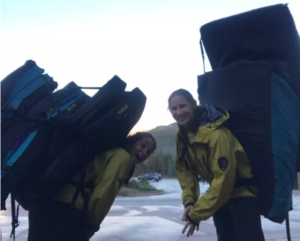
Notes from a Wilderness Medical Society study:
“Methods. – Yosemite Search and Rescue (YOSAR) personnel record every search and rescue mission on a Search and Rescue Incident Report. The information contained in these reports was used to perform a retrospective review of all SAR missions within YNP during the 10-year study period between January 1990 and December 1999.
Results. – YOSAR performed 1912 SAR missions, assisting 2327 individuals and recording 2077 injuries and illnesses. Popular trails in and around Yosemite Valley collectively accounted for 25% of all individuals needing SAR services. Lower extremity injuries and dehydration/hypovolemia/hunger were commonly identified reasons to need SAR services. The duration of SAR missions averaged 5 hours, used 12 SAR personnel, and cost $4400. Helicopter was the primary mode of transport in 28% of SAR incidents. There were 112 fatalities, yielding a SAR case fatality rate of 4.8%. The majority of fatalities occurred while hiking/snowshoeing, with falling the most common mechanism of lethal injury.
Conclusions. – Day-hikers in and around Yosemite Valley use a large portion of SAR services, with lower extremity injuries and dehydration/hypovolemia/hunger the most common reasons. It seems reasonable to direct future intervention to prevention of these commonly identified problems in this particular population of Park visitors.”
2024 Yosemite National Park SAR (Search and Rescue) Incident Summary
Total Yosemite SAR incidents: 191
Major SARs (Greater than $500) Fiscal Year 2024: 90
Major SARs FY 25 to date: 12
Total Mutual Aid YOSAR responses (off park): 7—including Hurricane Helene and two high elevation alpine short-haul body recoveries.
Total Yosemite Fatalities 16
YOSAR conducted body recoveries in Yosemite: 9
YOSAR body recoveries out of park to assist other jurisdictions: 2 (Conducted by Helicopter Rescue Team (HRT)/Helicopter 551 Short haul)
Total multi-day searches/recoveries: 5
*Total number of people not found: 0
Total SARs using aviation: 39
YOSAR/HRT-551 Short hauls: 16
YOSAR/HRT- Helicopter Rappel: 3
YOSAR/HRT-CHP Hoist mission: 5
Other Helicopter Related Searches or Rescues/Recoveries CHP and 551 combined: 18
(*Historical context: Dating back to 1909 there are still 36 people whose remains are yet to found in Yosemite.)
2021 Yosemite National Park SAR (Search and Rescue) DATA
Total Helicopter Evacs/Rescues/Short Hauls: 35
Total Searches: 42
Total Carry outs/Wheeled Litters: 52
Total Assists/Walk Outs: 43
Total Technical Rescues: 18
Total Confirmed Fatalities: 6
Month with Most SARs: June
Total Incidents: 190
These stats are courtesy of FOYOSAR (Friends of Yosemite Search and Rescue)
501(c)(3) nonprofit | Tax ID: 54-2081466
Friends of YOSAR
PO Box 661
Yosemite National Park, California 95389-0661
“Yosemite Search and Rescue is one of the busiest wilderness SAR services in the country and averages in excess of one hundred rescue missions every year. As we continue through the busy season and beyond we hope for as few incidents as possible, yet are prepared to provide aid to lost and injured visitors who come to enjoy the grandeur of Yosemite.
Despite strong support from government funding, many aspects of the response program are made possible only through public donation. Proceeds from FOYOSAR’s fundraising efforts are utilized for the benefit of the search and rescue function in Yosemite National Park. Grants made by FOYOSAR cover training, human resources, equipment/infrastructure, visitor/peer education, and research/development of more safe and effective rescue methods. No donation is used to directly support rescue operations – the costs associated with missions are covered through Federal Accounts appropriated to the National Park Service.
– The FOYOSAR Board”
https://www.friendsofyosar.org/ has a link to donate
(Contributions are 100% tax deductible.)
The National Park Service often warns hikers :
“Avoid becoming dehydrated or experiencing heat exhaustion. Drink plenty and drink often; pace yourself; rest in the shade; eat salty snacks.”
“Replace sodium lost through sweat by supplementing your water intake frequently with salty, easily digested snacks, such as trail mix or nuts.”
Avoid salt tablets, as they can irritate your stomach and cause nausea and/or vomiting, can raise blood pressure, cause stomach ulcers, and seriously affect people with heart disease.
– – – – – – – – – – – – – – – – – – – – – – – – – – – – – – – – – – –
read about climbing regulations, the reasons behind them and practical advice on how to follow the rules, including fixed ropes, permits and sleeping on big walls, food storage, trash and human waste while climbing, bouldering, slacklining, and bolting ethics at: https://www.nps.gov/yose/planyourvisit/climbing_regulations.htm
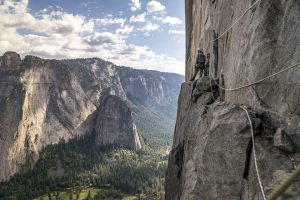
“Seasonal Climbing Closures March 1 – July 15
Please respect Peregrine Falcons nesting in Yosemite by complying with seasonal climbing closures. Starting Monday, March 1, 2021, closures go into effect at Arch Rock, B.O.L.T. Wall, Fifi Buttress, El Capitan, Fairview Dome, Hetch Hetchy, Lost Arrow Spire, Mt. Broderick, Rhombus Wall, the Rostrum, Sentinel Rock, Washington Column and Wawona Dome. If you want to climb at any of these areas, please check the closure notice (posted at http://www.nps.gov/yose/planyourvisit/climbingclosures.htm) first to make sure you are complying with the closures and not disturbing any nesting peregrines. Thank you for helping to protect Yosemite’s nesting peregrine falcons!”
https://www.nps.gov/yose/planyourvisit/climbingclosures.htm
Scroll around the almost 3,000 foot El Capitan Dawn Wall to look up close at climbers, a base camp of tents secured to the rock and follow their ropes during a 2015 free climb:
https://www.nytimes.com/interactive/2015/01/14/sports/the-dawn-wall-up-close.html
– – – – – – – – – – – – – – – – – – – – – – – – – – – – – – – – – – –
Rescue of Injured Climber from El Capitan
“On Thursday, September 11,” (2014) “at approximately 10:30 am, the Yosemite Emergency Communications Center (ECC) received an international call from a woman stating that her husband’s climbing partner had sent her a text from El Capitan requesting a rescue. A 39-year-old male climber fell while climbing pitch 25 of 31 (the Glowering Spot) on the Nose route, which is a 2,900-foot climb (Grade VI, 5.14a or 5.9 C2). The subject, along with his climbing partner, had slept at the base of pitch 25 on their second night on the wall. The subject began leading pitch 25 at about 9 am, aid climbing off a ledge above where the two climbers had slept. As the subject climbed, he placed protection gear: one stopper, followed by a second stopper, and then a cam. The cam pulled out and the subject started falling, hitting the ledge about 20 feet below him; as he fell beyond the ledge, the first stopper caught him. Later examination revealed that the second stopper was still in the wall with the quickdraw (a piece of webbing) hanging from it, but the lower carabiner, which had been clipped to the rope, was gone. The climbers do not know whether the carabiner broke or became unclipped during subject’s fall. As a result of the fall and hitting the ledge, the subject had severe lower back pain. . . ”
The above is from a detailed description of the rescue at:
https://www.nps.gov/yose/blogs/rescue-of-injured-climber-from-el-capitan.htm
Below, three NPS photos. In the left photo, Yosemite Search and Rescue (SAR) Ranger John Dill ( the author of the article above on this webpage) watched the climbers with a spotting scope and communicated with them by megaphone, in the center photo a rescuer was delivered to the top of El Capitan by helicopter, and the right hand photo shows rescuers sitting by their rigging.
https://www.nps.gov/yose/planyourvisit/climbingpermits.htm
said, in mid 2024:
“A wilderness climbing permit is required for all overnight big wall climbs. Permits for climbers are available by self-registration, are free, and there are no quotas or limits on the number of permits available. The permit system helps climbing rangers better understand use patterns on big walls. It will also increase compliance with existing regulations (e.g., proper disposal of waste) and minimize impacts to wilderness character through improved education.
Permits are available by self-registration (24 hours per day/7 days per week) near El Capitan Bridge at a kiosk near the food lockers. Permits are also available near El Capitan Bridge (look for a kiosk near the food lockers). Pick up your permit the day before or day of the start of your overnight climb.
During the busy season, climbing rangers are available at the Ask-A-Ranger climber program at El Capitan Bridge from 12:30 pm to 4:30 pm for more in-depth big wall leave no trace and climbing technique advice, safety tips, and route condition information.”
– – – – – – – – – – – – – – – – – – – – – – – – – – – – – – – – – – –
People climb over barriers meant to protect them, or try to swim above waterfalls and as a result slide over waterfalls in Yosemite. fatal, near fatal or close call incidents/accidents in camping, backpacking, climbing and mountaineering has press releases about them.
– – – – – – – – – – – – – – – – – – – – – – – – – – – – – – – – – – – – – – – – – –
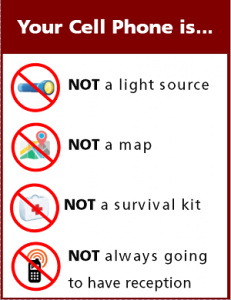
Cell phones in the wilderness has advice on how/when to use a cell phone to contact 911 in the wilderness and a warning about interference between cell phones, iPods and avalanche beacons.
– – – – – – – – – – – – – – – – – – – – – – – – – – – – – – – – – – – – – – – – – –
You can’t always expect a helicopter rescue
– – – – – – – – – – – – – – – – – – – – – – – – – – – – – – – – – – – – – – – – – –
The use of cell phones for photography (with or without a selfie stick) has made preventable injury or even death by selfie common
They were just taking a selfie . . .
“If you are close enough to take a selfie with an animal, you are too close. ”
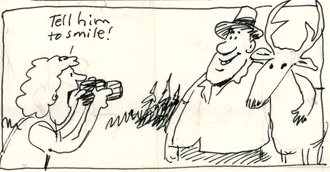
Thunderstorm and lightning safety includes a warning about not using your cell phone or IPod during a storm.
photo from the park service, fine dining on El Capitan:
– – – – – – – – – – – – – – – – – – – – – – – – – – – – – – – – – – –
and see places to take photos of El Capitan
– – – – – – – – – – – – – – – – – – – – – – – – – – – – – – – – – – –
“El Capitan, Nose Route VI 5.11 A3
El Capitan, Salathé Wall VI 5.10 A3”
Are each listed as one of the Fifty Classic Climbs of North America, by Steve Roper and Allan Steck.
“At 5.9 C2, the Nose is considered to be the easiest full-length route on El Capitan, which makes it extremely popular and draws relatively inexperienced big-wall climbers. But the Nose also is a complex climb, requiring a large repertoire of techniques that may be unfamiliar to newcomers. . .” read more at: https://www.nps.gov/yose/blogs/danger-zones-the-nose.htm
__________________
The American Alpine Club has a webpage of El Capitan Accident History, 1973–2013
A spreadsheet of all accidents on the Nose of El Capitan in Yosemite resulting in multiple broken bones, hypothermia, severed thumbs and even deaths, can be found at:
https://publications.americanalpineclub.org/articles/13201213411
it includes links to the details of “probable” causes of each accident, including
Bad placement, belay error
Inadequate protection
Rappel, Stranded – Unable to locate anchors
Failure to remove safety knot when rappeling
Misjudged pendulum
Pendulum Crash – Too little rope
falling rock from climbers above – no helmet
Bad placement, no self-belay
Possible jumar technique, possible compromised rope
Weather, Stranded – Inadequate gear – Hypothermia
Bad placement, tangled in gear
______________________________________________
And see:
Rappellers Rescued off of El Capitan
“One of the two rappellers had a climbing helmet. . . This climbing party had some multi-pitch traditional climbing experience but no big wall or aid climbing experience. This incident is a good example of the dangerous cascade of events that can occur when a team is ill-prepared for what is a very serious undertaking. Although climbing El Capitan and other long big wall routes has become increasingly popular, it is still a committing endeavor that requires extensive climbing experience and rope/rigging knowledge in order to be completed safely. Climbers and rappellers attempting to rappel big walls should ensure they have the skills and equipment to troubleshoot and adapt in the event that things do not go as planned. Being able to ascend a rope is a fundamental skill that no rappeller, especially one on such a large cliff, should be without. The consequences of unpreparedness can be, and have been, grave for many parties, and mounting a rescue mission always causes risks for rescuers.”
Injured Climbers Rescued from El Capitan
“Helicopter 551, Yosemite’s fire and rescue helicopter, flew a team of 14 YOSAR members to the top of the Nose . . . Meanwhile, an afternoon thunderstorm approached from the east end of the Yosemite Valley.”
Climber Fall on “Lurking Fear” “The placement of multiple questionable pieces of gear (which were used to provide protection in case of a fall) in a row was perhaps the main contributing factor to this accident. Perhaps most importantly, this is a reminder of how helpful helmets can be in preventing serious head trauma. According to medical personnel on scene, it is very likely that the climber’s head injuries would have been much more substantial had the climber not been wearing a helmet.”
Rescue from Muir Wall on El Capitan.
Leave no trace camping has these basic principles:
Plan Ahead and Prepare
Travel and Camp on Durable Surfaces
Dispose of Waste Properly
Minimize Campfire Impacts
Respect Wildlife
Be Considerate of Other Visitors
examples and details of how easy this can be are at: Leave no trace
(Grand Teton National Park) Jenny Lake Climbing Rangers advised climbers:
Be Courteous. Let faster parties pass on climbing routes when safe to do so.
Get away from it all! Choose routes that are less popular to help alleviate overcrowding. Get an early start on climbs that are popular.
and they offer more details about how climbers can leave no trace at:
https://tetonclimbingethics.blogspot.com/
– – – – – – – – – – – – – – – – – – – – – – – – – – – – – – – – – – –
The there is no guarantee of rescue webpage
includes accident prevention tips many people who are experienced hikers and backpackers do not know about.
https://mra.org/wp-content/uploads/2016/07/nps-swiftwater-rescue-manual-rev09-23-2012-SMALL.pdf
https://mra.org/wp-content/uploads/2016/05/SARforleaders.pdf
https://mra.org/wp-content/uploads/2016/05/Situational-Awareness.pdf
https://mra.org/wp-content/uploads/2021/11/Helicopters-in-SAR-Rev12Nov21.pdf
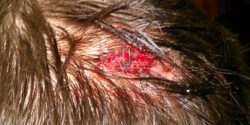 “If I had been wearing my helmet, I would have been fine.”
“If I had been wearing my helmet, I would have been fine.”
https://nps.gov/yose/blogs/church-bowl-self-rescue.htm
(Note to on-line users not in my classes: this is a study sheet. It is not complete instruction in the topic named in the webpage title.)
The author of this webpage, (written as a homework reading assignment for my students), does not give any warranty, expressed or implied, nor assume any legal liability or responsibility for the accuracy, completeness, or usefulness of any information, product, or process included in this website or at websites linked to or from it. Users of information from this website assume all liability arising from such use.

